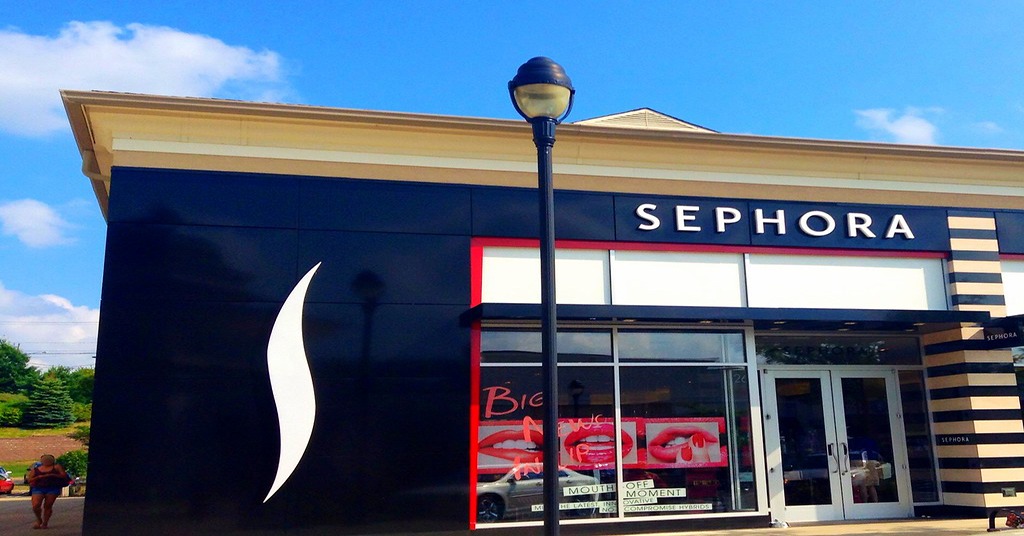Today, we’ll discover the secrets of its success through the lens of history

Sephora: beauty empire’s history of success. Dource: flickr.com
The Sephora empire of makeup, skincare, and fragrance has been a true mecca for all beauty-lovers for over 50 years now.
Sephora today
As of now, Sephora operates over 2,600 stores in 36 countries worldwide, with an expanding base of over 500 smaller-format stores across the Americas. It caters to all sorts of beauty-lovers with the original top-brand cosmetics and its own in-house line of affordable products. Sephora’s loyal customers are welcome to join the Beauty Insider Community while getting exclusive benefits and rewards.
At the beginning of 2020, the largest ever Sephora destination opened in Kuala Lumpur, Malaysia. The two floors with a total area of 17,000 square feet present over 10,000 products from 100 brands. The world’s biggest Sephora is much more than a shop, it’s a whole beauty kingdom. Interactive kiosks, Beauty Loft, an event lounge, and a photography studio – are all tucked in under a single roof.
After the announced bankruptcy of JCPenney which hosted a number of smaller Sephora stores, the beauty behemoth reached a new strategic partnership. Sephora will be replacing all cosmetics areas at Kohl’s with 2,500 square foot shops, starting with 200 locations in the fall of 2021.
This way, the beauty empire keeps growing while many other retailers are crushed by the coronavirus pandemic. How does Sephora manage that? Let’s find some answers in its history.
How it all started
The well-known fact is that Dominique Mandonnaud founded Sephora in France in 1970. Painter and sculptor Mandonnaud got his first job as a soap seller in his parents’ store. Quite soon, he opened a perfumery shop of his own.
What was first called Shop 8 soon formed the first network of self-service perfumery stores in France in a series of acquisitions. Paris Sephora’s shop was one of the acquired locations that gave the network its new name. Dominique Mandonnaud’s most revolutionary innovation was applying the concept of self-service to the world of perfumery and makeup. For the next fifty years, it became a norm for the industry to offer production testers along the aisles. Before Sephora, people bought cosmetics like a cat in the sack or asked the shop assistant at the special counter to give them a try. That confined the industry potential to small local stores.
The Sephora chain had grown to over 50 retail stores by the 1990s. After opening the flagship store in the Champs Élysées, the brand was bought by LVMH Moët Hennessy Louis Vuitton, the world’s leading luxury goods group. The €344 million deal gave Mandonnaud the chance to finally concentrate on his true passion – sculpture, while the brand started an aggressive expansion.
Sephora opened its first US store in New York in 1998, its first Canadian store in Toronto in 2004, its first Mexico store in Mexico City in 2011, and the first Brazil store in São Paolo in 2012. Sephora extended its operation to the Middle Eastern markets in 2007 and opened over 40 Sephora UAE and KSA stores. In October 2006, Sephora began opening stores inside JCPenney. The company also began its expansion in India at the beginning of 2018.
Business model & innovations
The unconventional approach to the physical retail space singles out Sephora as a top destination for customers. The beauty here is treated as art. With the help of makeup, people can create different images for their various life roles. Hence, Sephora employees use language suitable for theatre to describe their activities. The sales floor is called the “stage,” while all other premises are “backstage.” Sales associates in uniforms are “cast members” wearing “costumes” and managers are the “directors.” Every cast member is hired, trained, and certified to be an expert in a specific realm or “world” as they call it at Sephora, like fragrance, color, or skincare. That allows the employees to be more competent in their sphere and learn the “world” in depth.
Sephora stores are highly interactive. The brand leverages augmented reality for both in-store and in-app makeup trials. Selected locations function as Beauty TIP (Teach, Inspire, Play) Workshop concept stores. There you can find displays featuring Tap and Try technology which lets customers pick up any lip or lash product on the endcap and immediately try it on with the help of Sephora Virtual Artist technology and RFID scanning.
There are also frequent beauty classes, makeup and skincare tutorials, events, and presentations that happen both off- and online. Of course, today most of the events are virtual for healthcare reasons. Yet, some limited product testing is allowed in locations where it’s permitted by local health regulations with personal assistance from the store’s Beauty Advisors.
In addition, enabled beacon notifications allow Sephora’s proprietary app to recognize when a user is in a brand store and then provide a pop-up in-store map, daily promotions, as well as customized shopping offers based on the customer’s online shopping cart and wish list.
The company management puts a strong accent on digital experience and innovations. Virtual Artist app, chatbot assistance, in-app voice control, Beauty Board social media platform featuring shoppable content, in-store 3D augmented reality mirrors, scanning and saving your samples directly into the Sephora app, Color IQ exclusive foundation-matching technology that has recently inspired new Skincare IQ and Fragrance IQ services – the list of extraordinary customer service methods can go on and on.
The company’s website launched in the US in 1999 and it hosts one of the world’s largest beauty forums – Beauty Insider Community. Transition to proper shopping on-the-go took a while. Sephora created a dedicated mobile app only in 2010. However, the waiting was worthwhile. With the new app, customers could scan 2D barcodes to access product reviews and detailed descriptions, read branded content, sync their Beauty Insider loyalty accounts across all devices, and create shopping lists. In another update, customers got a great new feature. The modern app version comes with an artificial intelligence (AI) extension called Virtual Artist. It uses facial recognition technology to allow the client to virtually try on makeup products. The app then provides online links for the chosen shades of products or gives instructions on where they can be found in a store.
Since Sephora’s digital and physical retail teams merged, the organization moved to the omni-retail model. They have updated customer profiles to include multi-channel data that tracks the whole customer journey. That ranges from online browsing and purchasing to in-store interactions with sales representatives and over-the-counter sales. Thus, Sephora can collect more information about shipping habits and better customize its marketing offers.
In 2007, Sephora launched a client loyalty program. In a few years, two premium levels (VIB – Very Important Beauty Insider and Rouge) were added. Those give clients access to exclusive gifts and offers, premium lounges and free makeovers, event invitations, and early access to select products.
The company strives to make its sales socially responsible. In 2018 Sephora announced its new Clean Beauty category, a curated collection of organic and eco-friendly products without sulfates, parabens, formaldehyde, and other potentially harmful chemical ingredients. It also launched an inclusivity-promoting campaign “We Belong to Something Beautiful” in 2019. Meanwhile, Sephora Stands initiative implements three core programs: Sephora Accelerate for women entrepreneurs, Classes for Confidence to support local communities, cancer patients, and LGBTQ representatives, and Sephora Stands Together for Sephora employees.
Due to the “Black Lives Matter” movement and mass protests following the death of George Floyd, Sephora said it would dedicate 15% of its stores’ shelf space to the products of black-owned companies, becoming the first major retailer in the United States to take the “15% pledge.”
More payment methods mean more buying opportunities. In 2019, Sephora introduced a range of credit card products: Sephora Credit Card, Sephora Visa Credit Card, and Sephora Visa Signature Credit Card. Sephora cardholders earn credit card rewards in addition to rewards in the existing Beauty Insider Program. Sephora Visa Signature cardholders also have access to additional Visa Signature benefits. In 2020, the company partnered with Klarna to provide an option of paying in installments.
Covid-19 impact
Before 2020, the company had already had a strong online presence and implementation of mobile technologies. Nevertheless, enhanced safety measures called out for more online services. Thus, expert Beauty Advisors in the stores started web-based consultations handling online product queries through video or text chats.
Sephora also started offering paid virtual consultations, which provide a more detailed conversation with specialists, along with queue reservations in the stores, allowing clients to check-in and get notified when it’s their turn. Some new purchase options were introduced. Those include a ‘Reserve-Online-Pickup-In-Store” option and a collaboration with Instacart to offer same-day delivery.
Although the company had to lay off 3,754 part-time and seasonal workers during the lockdown, and 7% of its full-time corporate workforce in the US, as part of a further restructuring effort, Sephora successfully continued to innovate, learn, and grow.
SEE ALSO:









